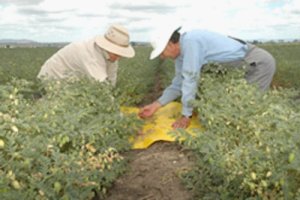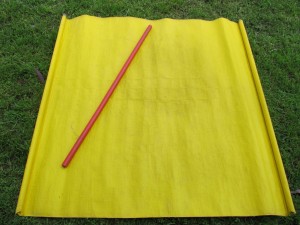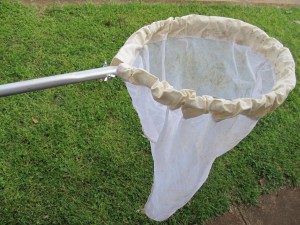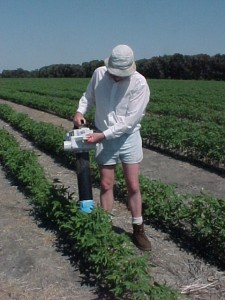On this page:
- What technique should I use?
- Monitoring tools
See also Monitoring for soil insects (soil insects page)
What technique should I use?
The table below indicates the most appropriate monitoring technique(s) for various pests at different crop stages.
| Pest/s | Crop/s | Recommended monitoring technique |
|---|---|---|
| Establishment crop stage | ||
| Earthmites | all seedling crops – winter | Visual |
| Lucerne flea | all seedling crops – winter | Visual |
| False wireworms | canola, sorghum, maize, sunflower | Soil sampling (Germinating seed baits, quadrats) |
| Cutworms | pulses, canola, cereals | Visual |
| Blackheaded pasture cockchafer | winter cereals, pasture | Soil sampling |
| Vegetative crop stage | ||
Cereal Aphids
|
winter cereals | Visual |
| Green peach aphid | Canola | Visual |
Pulse-infesting aphids
|
Pulses, pasture | Visual |
| Flowering – crop maturity stages | ||
| Armyworm species | barley, wheat, oats, triticale, pasture | Sweep net Visual for damage, frass and larvae on ground. |
Brassica-infesting aphids
|
canola | Visual |
| Cotton bollworm/corn earworm Helicoverpa armigera |
chickpeas, lentils, lupins, canola summer pulses sorghum, maize, wheat/barley |
Sweep net Cut-and-bash, Bucket Beat sheet Sorghum – Bucket |
| Diamondback moth | canola | Sweep net |
| Lucerne seed web moth | lentil, peanuts, Nato soybeans, field peas | Light trap Visual – check for eggs and larvae Visual – splitting pods to check for larvae |
| Mirids | summer pulses | Beat sheet |
| Native budworm Helicoverpa punctigera |
chickpeas, lentils, lupins summer pulses wheat/barley canola |
Sweep net Beat sheet Cut-and-bash Bucket |
| Pea weevil | Field peas | Sweep net |
| Podsucking bugs | Summer pulses | Beat sheet |
| Rutherglen bug | Sunflower, sorghum, canola | Bucket |
| Slugs | All crops | Shelter trap |
| Sorghum midge | Sorghum | Visual |
Beat sheet
A standard beat sheet is made from yellow or white tarpaulin material with heavy dowel on each end. Beat sheets are generally between 1.3-1.5 m wide by 1.5-2.0 m deep, the larger dimensions being preferred for taller crops. The extra width on each side catches insects thrown out sideways when sampling and the sheet’s depth allows it to be draped over the adjacent plant row. This prevents insects being flung through or escaping through this row.
How to use the beat sheet
- Place beat sheet with one edge at the base of plants in the row to be sampled.
- Drape the other end of the beat sheet over the adjacent row. In crops with wide row spacing (1 metre +) use inter-row space and up against base of the next row.
- Using a one metre stick, shake the plants in the sample row vigorously in the direction of the beat sheet 5-10 times. This dislodges insects onto beat sheet.
- Use a datasheet to record type, number and size of insects found on the beat sheet.

- Reducing the number of beat sheet shakes per site greatly reduces sampling precision. The use of smaller beat sheets, such as small fertiliser bags, reduces sampling efficiency by as much as 50%.
- One beat does not equal one sample. The standard sample unit is five non-consecutive one-metre long lengths of row, taken within a 20 m radius, i.e. 5 beats = 1 sample unit. This should be repeated at six locations in the field (i.e. 30 beats per field).
- The more samples that are taken, the more accurate is the assessment of pest activity, particularly for pests that are patchily distributed such as pod-sucking bug nymphs.
Sweep net
A sweep net is a large cloth net (about 60 cm deep) attached to a round aluminium frame (about 40 cm in diameter) with a handle (1 m in length).
The manner in which this sweep net is used can influence its effectiveness for collecting insects and, consequently, treatment decisions based on the number of insects caught.
To use a sweep net, swing it in a 180° arc so that the net rim strikes the top 25-30 cm of the canopy. Hold the net slightly less than vertical to facilitate getting the insects into the net. Each 180° arc counts as one sweep. A common practice is to take a sweep from right to left, walk a step, and take another sweep, left to right.
Watch the video to see how it’s done.
After taking the desired number of sweeps, quickly pull the net through the air to force all insects into the bottom of the net bag and grasp the net bag with a hand at about the mid-point. Slowly invert the net bag while releasing your grasp on the bag allowing the insects to escape and count the numbers of key species. Many slow-moving insects, such as weevil larvae, aphids, and caterpillars can be counted by turning the net onto a white pan or even the hood of a vehicle.
Divide totals by the number of sweeps to get the average number of insects per sweep. To get a good representation of insect numbers in the field, take sweep net samples in different areas of the field.
If the numbers are so large that counting in the field is difficult, the bag contents can be placed into a plastic or paper bag and the counting done after cooling the sample to slow down the insect movement. Pest management decisions, however, are generally made before such high numbers occur. Collect samples from all portions of the field but avoid unusual parts of the field, such as field edges, except where required for insects than tend to invade field from the edge e.g. aphids, pea weevils, mites.
Visual monitoring
Finding pests can sometimes be difficult for the inexperienced observer because of their small size, inconspicuous colours and/or because they hide by day.
The following tips will assist with monitoring;
Check the whole plant. When checking plants ensure you:
- Separate leaflets or flowers when looking for eggs or small larvae.
- Check under leaves and on stems
- Ensure that pests or beneficials present in the lower canopy are not overlooked.
- Visual checking of plants in a crop is also important for estimating how the crop is going in terms of average growth stage and other agronomic factors.
- Have a good sample size to give more accurate estimates of insect numbers
- Take a representative sample – lush areas near waterways may be more attractive to insects but this may not be representative.
- A good handlens will assist in finding small insects
Digging over the upper soil surface to uncover hidden pests (e.g. cutworm larvae, false wire worms and cockchafers). A suitable-sized soil sieve can be useful to separate insects from the soil.
Inspect underground root systems and soil beneath poorly growing plants – for underground species (e.g. Desiantha larvae or adult African black beetle which feed on cereal root systems).
Physically uncover – sift through plant material such as stubble and leaf litter for ground-dwelling insects (e.g. wireworms, weevils, earwigs and slugs) and also in the inter-row spaces (e.g. armyworms). Turn over bits of wood, stones and soil clods to find sheltering pests (e.g. weevils and slugs).
Spraying small patches of crop, such as two square metre areas, with an insecticide can kill off whatever pests are in the sample area. Inspection of this sprayed area early on the following day may expose hidden pests (e.g. weevils, false wireworms and cutworm). Laying trails of poison baits overnight and checking early on the following morning will reveal areas of a paddock where snails and slugs are most prevalent.
Suction sampling
Suction sampling (sometimes called D-vac) is a sampling method that uses a vacuum machine. Suction sampling is most effective in dry, upright vegetation less than 15 cm tall. This method is not effective for larger pests (e.g. some beetles) or those species that live below the soil surface.
A standard petrol-powered garden blower/vacuum machine may be used for suction sampling. A gauze bag or mesh container must be fitted into the suction tube to collect invertebrates while the motor is running at full speed. Place the suction tube opening directly over plants – bare soil areas should be avoided. Invert the suction machine while on full revs before stopping to withdraw the sample bag or mesh container. Transfer samples into a tray where the species collected can be identified and counted.
Main species targeted with suction sampling include: earth mites, lucerne flea, weevils, mirids and predatory mites.
Cut and bash
Select individual plants – picked at random. Cut plants near ground level with secateurs. Bash plants over a large plastic rubbish bin (or similar) to dislodge insects. Record individual results to get average numbers per plant. This can also be used to calculate the number of larvae per square metre if the plant numbers per known area or row-length are counted.
Bucket sampling
Sometimes using a beat sheet or sweep net is not suitable to check for pests in some crops. Sampling for native budworm in canola may be more effectively done by using a bucket.
- Heads can be beaten into a container to dislodge pests.
- Sample 10-20 plants
- Determine pest density according to the average crop density
Bucket sampling can also be used in other crops e.g. sorghum, and sunflowers for pests such as Helicoverpa and Rutherglen bugs.
Lucerne flea (LF) sticky trap for sampling in pastures
- Cut a piece of 90mm diameter PVC pipe (140mm length) in half – length ways.
- Tape the two halves together on one side to create a hinge.
- Smear the inside of the pipe with a sticky substance (e.g. Rentokil ‘Birdrid’), to a height of 80mm.
- Hold the cylinder closed and place it quickly over an area of pasture
- lucerne flea will spring up and become trapped on the inside of the cylinder
- Blowing air, in short blasts, into the top of the cylinder will disturb any remaining lucerne flea
- Remove the trap and open, counting the trapped lucerne flea as they are removed from the trap.
- Repeat the sampling and counting at 10 sites across the paddock.
After using the trap 3-10 times it needs to be cleaned and re-treated with sticky trap. The area sampled by the trap is approximately 63 cm2 (convert the estimate of LF density to a per metre basis by multiplying by 158). Sampling should be avoided during heavy dew and cold, damp conditions.
Shelter traps
Shelter traps are useful for monitoring slugs which are active at night and difficult to locate during the day. The shelter traps provide a cool, moist, dark environment for slugs to shelter in during the day, and are easily monitored.
Shelter traps can be made from anything that provides a cool, dark, moist shelter. Commonly carpet squares, hessian bags, terracotta tiles are used.
- Place the traps in the field when the soil is moist.
- Use traps from sowing through to establishment.
- A number of traps are required to get a good indication of slug activity as slugs can be patchy through the field.
- If seedlings are being damaged, place traps in the areas where the damage is occurring.
- Leave the traps in place and check them every few days.
- Placing a small amount of bait under each trap can increase the attractiveness of the traps.



